#HappyHalfBirthday @Twitter
Twitter is awesome. Its year-over-year new user adoption rate proves it. And it’s why I can’t wait another six months to celebrate its awesomeness.
Twitter was founded in March 2006 by Jack Dorsey, Evan Williams, Biz Stone and Noah Glass. By 2012, it had garnered over 500 million registered users and hosted 340 million tweets per day. Today, two years later, there are almost 650 million users. That’s more than triple the amount of users on Instagram and Pinterest combined. Needless to say, if your consumer brands aren’t on Twitter, you’re very likely missing out on a goldmine of opportunities to engage with your customers.
Assuming that your brand is on Twitter (ok, here is the ½ tip: if your brand isn’t on Twitter, please open Twitter in a new tab, sign up, then come back and keep reading…), you have probably seen a number of articles about brand follies on Twitter. US Airways, JP Morgan, The Home Depot and PayPal have all fallen victim to viral “Twitter Fails”, some to the extent that they had to take public action in an effort to rectify the respective misfire. This goes to show that anyone is susceptible to the social hot seat. On the flip side, successes and authentic brand communication have shone through both from branded content and with spontaneous human interactions (see Sainsbury‘s recent punny consumer encounter over a fish purchase gone overboard).
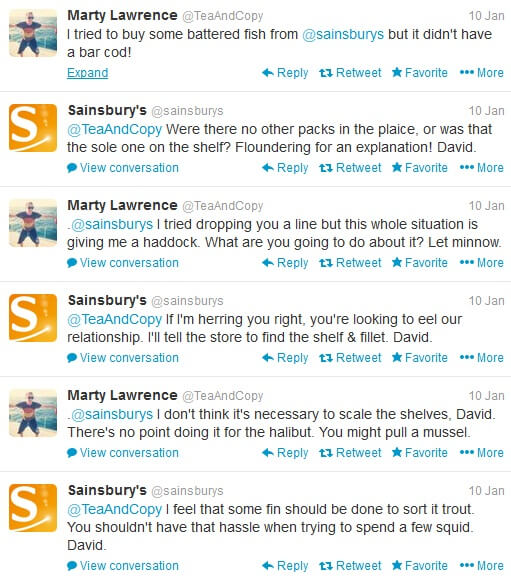
Have no fear: we want to share a set of basic guidelines that will help you run a smooth Twitter feed for your brand. Remember, nothing can prevent all errors – but these tips for Twitter could open your eyes to some new ways to secure the name and image of your brand while engaging your biggest fans and favorite customers.
1. Automated reply tweets are like swimming in shark-infested waters
Automation and social media are polar opposites when you boil them down. The premise of ‘social’ is engagement. If you want to gain and retain real fans and customers through social engagement, each interaction should be a genuine and tailored communication at the one-to-one level. Use of automated replies have gotten some top brands in hot water: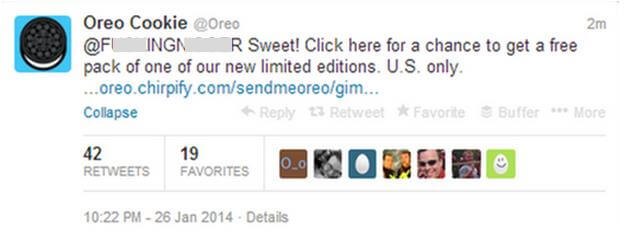
2. Use caution and creativity in selecting your Twitter profile header image
Twitter made a smart move in the competitive social media sphere when they implemented the use of header images. It gives brands the opportunity to select a hero image that reflects their image and personality. It’s important to keep in mind who and how many people are going to see this image. Here are a set of questions you should ask before going live with your header image:
1. Does your image accurately represent what you are trying to accomplish with your Twitter feed?
2. Could your image offend anyone?
3. Are you using an image people will enjoy looking at (aesthetically and fundamentally)?
4. Does your image highlight what people know about your brand?
5. Is your image original and creative? Is it an image people will not only identify with, but will provoke a higher affinity for your brand?
Check out these Twitter header images for inspiration:
Burton Snowboards: Notice they aren’t flaunting their product line? That’s ok; they’re showing how you can feel when using a Burton board (I personally ride a Burton – oh, yeah!).

Western Union: WU wants to reassure their customers of the value, ease and security in using their services… I don’t know about you, but when I see this image, I’m certainly comfortable!

The UPS Store: Catering to a multitude of personas and business sizes, the UPS Store has found a way to identify with everyone – the collage!

3. Gauge before you engage
Much like other life scenarios, it’s wise to listen first and think about what you’re hearing…then engage. In the case of Twitter, just remember that once you tweet something, it will live virtually forever. Sure, you can delete a tweet – but what if it’s already been captured by a thousand trigger happy Snag-It yielding bloggers? Being smart with Twitter means you have to stay ahead of that curve. Tweets are a lot like writing an email to your CEO. Would you fire that email off without reading it, sitting on it for a while, then re-reading it later with a different mindset? I certainly would not.
When you listen to what your audience is saying, you have to evaluate things that don’t always transmit over a tweet. Is there sarcasm? What’s the real tone of your customer? How are they positioning themselves? Does their tweet warrant a direct, public response? Have others jumped on their bandwagon?
There are a number of factors to evaluate before pushing ‘send’. One practice that you can use is the triple-eye-pass-through. (Admittedly, I just coined that term.) You can do this by writing the tweet, but letting it pass by three sets of eyes for approval before firing it out into the social sphere.
4. Hashtag overkill will annoy your customers – take it easy!
My 3-year-old knows what spam is. So does my great aunt. Neither of them like it, and your followers probably won’t either. Use hashtags that are relevant, and try to keep it to no more than two hashtags per tweet. If you’re unsure of what a particular hashtag means or is categorized as, visit a directory like tagdef.com first to make sure you’re not putting a damper on your brand’s name.
Apart from the sheer overkill, remember there is a 140-character limit on tweets and your hashtags count toward that threshold. Replies and retweets will drop in volume if they don’t fit within the confines of Twitter regulations.
5. If you’re not an acronym ninja, YDKWYD
Your customers are your customers because they like and trust you. They believe that you are savvy and cutting edge — maybe even just a bit more than your top competitor. That means they also expect that you can easily translate Twitter-speak, which is often abbreviated to accommodate the character limit.
If I typed out “you don’t know what you’re doing”, I just blew 23% of my tweet. Of course as a brand that plays it safe on Twitter, I’d probably never write that in public…but you get me.
6. Stop selling and start building
I could probably write a whole other blog on how to build relationships with Twitter…I take that back, it would be a book! But here is the bottom line: the safest way a brand can use Twitter is to always be helping their loyal patriots. By posting useful content, interesting perspectives and an extended set of expected odds and ends, you are fulfilling the promise to your fan base. I’d add to this list customer service and responding to tweets as mandatory.
If you’re sending mixed messages, you’re foregoing those valuable relationships – people will stop following and stop paying attention. This leads directly into my next tip…
7. Tweet with purpose and intent
When you keep brand intent in mind with every keystroke, your inclination to post socially erroneous messaging decreases. Your goal with every tweet should be to provide value, gain interest and retain support. Keeping those three goals in mind will help you stay on track and out of the sticky wicket. At the same time, it doesn’t mean you have to slack on creativity. Did you see what JCPenney did during the 2014 Super Bowl? Check this out:
First, followers saw this:
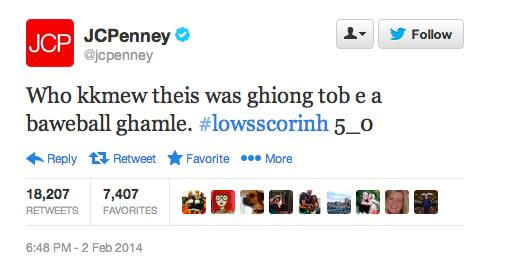
WHAT?!?!… then, 35 minutes later, this:
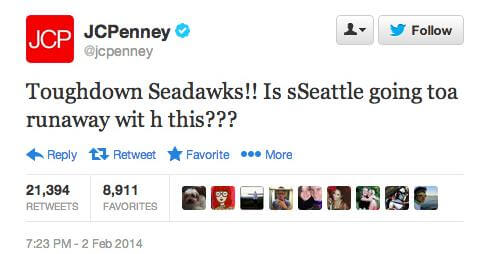
The reaction? OMG, JCPenney’s twitter account holder is drunk…must retweet (said over 21,000 people)! The result: it goes super-viral. But there was intent. Brilliant intent, I might add. 34 minutes later, this came out:
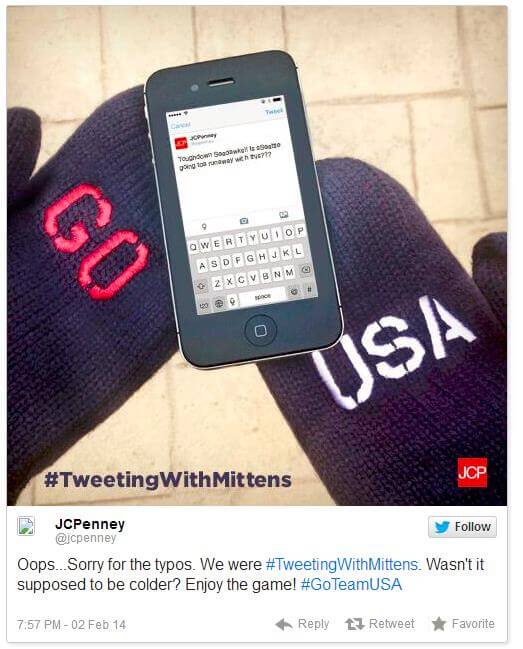
It was a plot to gain engagement and at the same time show support for Team USA at the upcoming Winter Olympic games. This resulted in some great publicity and thousands of new followers. Touchdown JCP! And kudos for pre-evaluating risk factors.
8. Set your sights on the right metrics
As a top-tier brand, the motto quality over quantity should be ingrained in your soul. Twitter, at the end of the day, is an engagement channel. If you are fishing strictly for a high volume of followers, you’re focusing on the wrong outcome. Volume is a goal that can lead to sending out an exorbitant number of tweets, which ultimately devalues each; it also increases your propensity to end up in the creek with no paddle.
If you’re focused individual engagements, you’ll see more yield from your account. Much like SEO, an organic approach leads to greater authority built on quality and trust. What would your brand rather have, a bunch of non-converting junk traffic, or a few paying, loyal customers that refer and advocate for you? I won’t answer that…
Using these guidelines while running your brand’s Twitter feed will help you stay safe and secure in the social sphere while organically building a strong fan base. Hopefully it will also keep you out of the bad publicity limelight as well! If you have questions on how to manage a successful Twitter feed, we’d love to hear about your challenges in the comments section below. Thanks!
Adam Picker, Director, New Business @DigitalNative1
Interested in finding out more? Contact us today!



